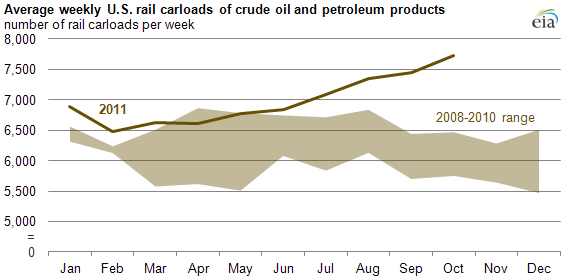
Rail delivery of crude oil and petroleum products rising

Note: Data are weekly average originations for each month, are not seasonally adjusted, and exclude U.S. operations of Canadian National Railways and Canadian Pacific Railway; one carload holds 30,000 gallons.
More U.S. crude oil is being shipped by rail, especially from North Dakota where a lack of pipelines has companies relying on tank cars to bring the state's soaring oil production to market. Pipelines remain the most popular transport option, carrying about two-thirds of U.S. oil and petroleum products, but rail is on the rise.
The Association of American Railroads (AAR) tracks combined rail movements of oil and refined petroleum products. In the first ten months of 2011, nearly 300,000 tank cars transported U.S. oil and petroleum products, up 9.1% from the same period in 2010, according to AAR. The growth in petroleum-by-rail shipments is much stronger than the 1.8% increase for all railroad cargo combined during the same period.
While AAR does not issue separate data on crude oil and product shipments via rail, it notes that anecdotal evidence indicates most of the growth in the crude oil and petroleum products category is likely due to crude shipments. Based on different sources of rail traffic data, the trade group said shipments of crude oil and liquefied natural gas accounted for about 2% of all carloads in 2008, 3% in 2009, 7% in 2010, and about 11% so far in 2011. One carload holds 30,000 gallons of oil.
Tank cars are in strong demand in North Dakota, where oil production has soared from about 343,000 barrels per day (bbl/d) in January to a record high of about 464,000 bbl/d in September, according to North Dakota's Department of Minerals Resources (DMR), due to the increasing amount of crude oil extracted from rock in the Bakken Shale. DMR expects North Dakota will pass California during the second quarter of next year to become the third biggest oil-producing state. Burlington Northern Santa Fe (BNSF) and other railway companies are building or expanding terminals and adding tank cars to transport North Dakota's growing oil supplies to Gulf Coast refineries.
On November 7, the first crude oil unit train on the Bakken Oil Express, a newly constructed rail hub near Dickinson, North Dakota, departed via the BNSF Railway carrying its first shipment—70,000 barrels of crude oil destined for St. James, Louisiana. The Bakken Oil Express receives Bakken-area crude oil by both truck and pipeline and has a current takeaway capacity of 100,000 bbl/d. The Bakken Oil Express is already planning a second phase of construction that would significantly expand its takeaway capacity to more than 250,000 bbl/d.
Deliveries of tank cars should total about 8,000 this year, up from only 4,839 last year, and then increase to 11,000 tank cars in 2012, according to Economic Planning Associates Inc., a consulting firm that tracks rail car assemblies. The firm does not have a breakdown of how many of the new tank cars will be devoted to carrying crude oil. Tank cars are also used for shipping ethanol, chemicals, fertilizer, and corn syrup.
Tank cars would also be useful in the major oil hub of Cushing, Oklahoma, where a glut of supply is depressing the key U.S. benchmark crude oil price. Pipelines bringing oil into Cushing from the north are nearly full and there is not enough pipeline infrastructure to move oil south out of the area to Gulf Coast refineries. The Surface Transportation Board (STB), the federal agency that resolves railroad rate and service disputes and reviews railroad mergers, told EIA that it saw little movement in recent months of crude oil out of Cushing by rail. Railway companies send the STB confidential information on their cargo shipments and where they are sending them.